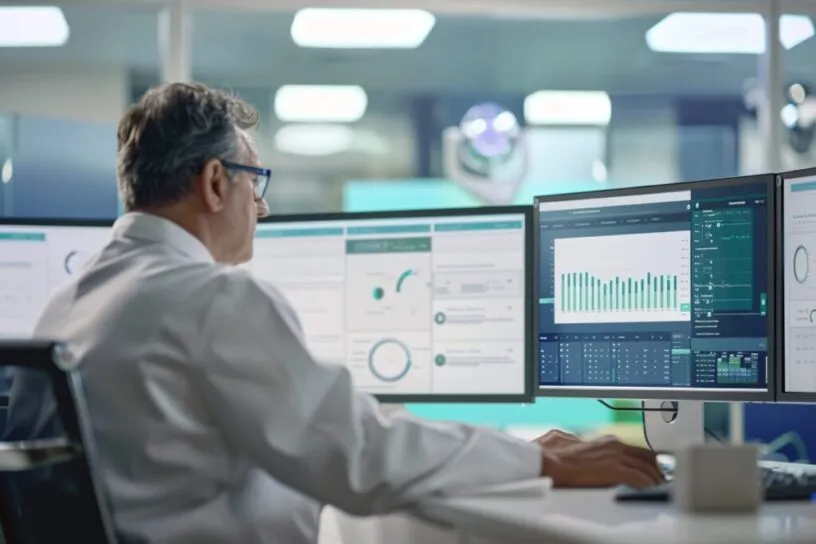The Advantages of AI for Clinical Trial Sites

Sites are the core of every clinical trial. But in today’s environment with limited resources and increasingly complex protocols, they need stronger partnerships and better support. This doesn’t mean inundating site staff with as many technologies and tools as possible, however. Instead, they must be strategically empowered to spend more time on the tasks that matter—such as communicating with patients—and less time on repeated, automatable tasks like data entry.
Artificial intelligence (AI) is changing the game. In this constrained ecosystem rife with funding and staffing shortages, it’s more important than ever that sites are equipped with everything they need to succeed. By freeing up valuable time and introducing a surge of efficiency, quality, and speed, the benefits are clear and are only expected to grow as capabilities continue to evolve.
Streamlining Workflow Development
AI is already stepping in to reduce administrative burden and drive greater operational agility. Time-consuming activities including scheduling, calendar management, and data entry can be offloaded onto AI tools, allowing clinicians to focus on the higher-lift components of a study.
Even for more complicated tasks like eSource creation, AI-powered solutions can scan protocols and produce drafts for experts to refine and iterate on, rather than starting from scratch. Taking it a step further, AI can also help sites identify a trial’s operational workflow.
Traditionally, developing this workflow is similar to being handed a box of puzzle pieces with no complete picture on the packaging. Site staff must sift through each piece—protocols, EDC manuals, procedure guides—simply to determine what they’re looking at and how it all fits together.
AI tools can change that. They help sort the puzzle, grouping corner pieces, edges, and center sections, so sites obtain a clear outline and logical path to completing the picture faster and with more confidence.
“Site staff currently spend hours reviewing materials to understand what's required operationally for each study. An AI-powered tool could help minimize that time burden by reviewing the protocol, the EDC manual, and all the pieces and parts to provide a starting point for what a potential workflow could look like.”
– Robin Douglas, VP, Research Site Engagement, Medidata
Better, Faster Recruitment
Recruiting patients is a major challenge—especially for independent sites. AI can accelerate this process by matching inclusion and exclusion criteria with pre-screening forms, CTMS, eSource, and/or medical records, generating lists of eligible patients, and reducing unnecessary pre-screening appointments.
This is a direct benefit for patients as well. If AI can reduce or eliminate pre-screenings with ineligible patients, both patients and sites will get valuable time back—avoiding additional travel costs and a frustrating experience for all parties involved.
There’s a cost-savings element too. Sponsors typically impose a limit on how many pre-screening sessions (i.e. the number of patients that can be pre-screened) they will compensate for. For some studies, sites could end up talking to hundreds of patients to reach one who’s eligible—and if they aren’t getting reimbursed for that time, the site itself may not be able to participate in the study at all.
“We can provide the cleanest, most accurate, potential patient information that would lead to that conversion of enrollment. Everybody wins: sites use less resources to get to that point, the conversion rate will hopefully get them more patients within the sponsor’s limit, and they will get reimbursed for the time spent.”
– Robin Douglas, VP, Research Site Engagement, Medidata
Sustainability and Overcoming Adoption Hurdles
Adoption speed is an ongoing challenge. Sites crave efficiency, and they need the various tools they use to integrate with one another. The power of a unified platform accessible with a single login cannot be understated; when all the tools in a site’s arsenal talk to each other and seamlessly work together, the experience becomes infinitely more streamlined and powerful.
Sites are increasingly inundated by the number of technologies and vendors a sponsor may ask them to use; many sites are grappling with over 20 systems on a daily basis. This isn’t sustainable, and AI-powered tools are essential to reducing this technological burden. Nonetheless, a fundamental mistrust persists that must be reduced through continuous demonstration of AI’s value as a partner—not a total replacement of human knowledge and expertise.
Initiatives such as Medidata’s Site Insights Program promote a more open dialogue with sites, revealing concerns that can proactively be addressed in the design of the tools they will ultimately use. This results in AI-powered solutions that solve their problems while fostering trust from the jump. Sites need more than support; they need partners that can introduce new ways to connect the dots and eliminate the roadblocks in their way.
A More Compliant Future
Potential future AI applications for sites include proactive compliance monitoring, with automated alerts flagging a patient’s likelihood of becoming noncompliant with their medicine or treatment, allowing site staff to intervene efficiently. Imagine how much time could be saved if this monitoring occurs in the background as they focus on other tasks. Data anomalies falling through the cracks could become a thing of the past.
Live support may transform to be even more proactive as well, with AI agents that respond to a site’s real-time needs or simulate site feasibility scenarios during protocol design to flag risks before they even appear.
Intelligent Assistants
In an EHR system, data is captured in different ways: both “structured” and “unstructured”.
Structured charts and forms have discrete fields. They can contain data generated from a lab, a device, or generated by a doctor—such as getting your blood pressure taken at an appointment, and the machines feeding that data directly into the system.
Data in structured charts can be processed by today’s technologies, allowing site staff to pull up relevant information about a patient (like a list of medications they may be on) according to the EHR system. Tools like Rave Companion present this to site staff, letting users pick and choose the data they want to bring over.
On the other end, unstructured information can come in the form of a list of notes or interpretations that a doctor may write during an appointment, including details such as how a patient feels, and other descriptions of what’s happening with that individual. This can be more challenging for current tech to reference as it requires understanding the context and knowing what’s important and relevant to the trial.
Regardless of how information is captured in an external system—structured or unstructured—the data exists. The questions site staff have are being answered; they’re just being answered somewhere else in the data. It’s the process of hunting it down, understanding its context, and identifying what is relevant that AI holds such promise.
EDC and EHR tools may evolve into fully intelligent data entry assistants that not only help site staff find and determine the right information to bring in, but also proactively suggest what data should be carried over and answer questions with the full picture in mind. Rather than tools asking a set of questions and staff selecting the answer, we see these tools becoming intelligent enough to evaluate all data in parallel—regardless of how it was entered—and proactively suggest these answers directly.
When AI can do the work of connecting the dots, humans reclaim precious time that can be spent on taking action and carrying out more important tasks, such as working with patients. These current and future advancements concern more than efficiency; they’re about sustainability in a strained ecosystem and helping sites not just survive, but truly thrive and evolve.
Sites aren’t the only ones seeing these benefits. See how AI is impacting patients, and learn more about Medidata’s AI Everywhere approach.
Contact Us
